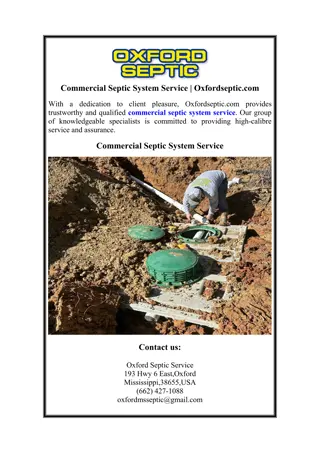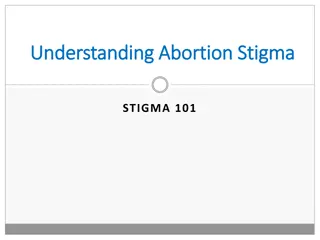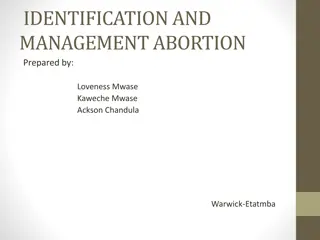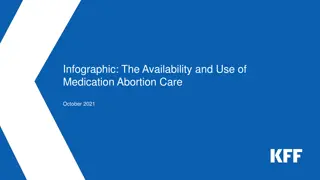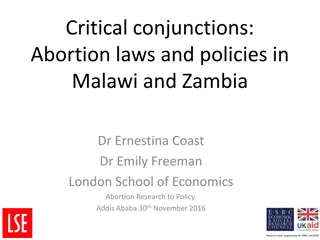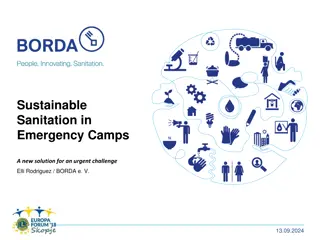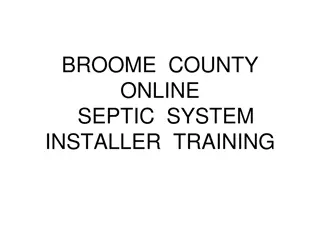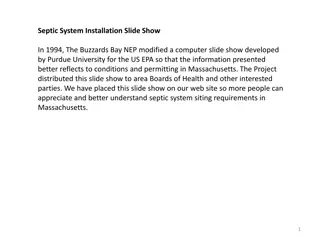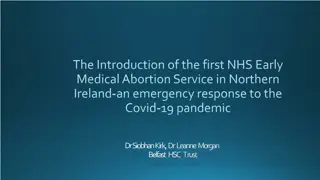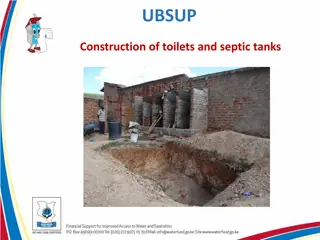Septic Abortion: Causes, Symptoms, and Management
Septic abortion refers to an infection of the uterus and its contents following an abortion. This includes clinical manifestations, mode of infection, pathology, clinical features, and grading. Discover more about the definitions, causes, symptoms, and complications associated with septic abortion.
Download Presentation

Please find below an Image/Link to download the presentation.
The content on the website is provided AS IS for your information and personal use only. It may not be sold, licensed, or shared on other websites without obtaining consent from the author.If you encounter any issues during the download, it is possible that the publisher has removed the file from their server.
You are allowed to download the files provided on this website for personal or commercial use, subject to the condition that they are used lawfully. All files are the property of their respective owners.
The content on the website is provided AS IS for your information and personal use only. It may not be sold, licensed, or shared on other websites without obtaining consent from the author.
E N D
Presentation Transcript
Dr Suman Gupta Obs & Gynae
SEPTIC ABORTION DEFINIATION: Any abortion assoiated clinical evidences of evidences of infection of the uterus and its contents, is called septic abortion. rise of temperature of at least 100.4 F for 24 hours or more; offensinve or purulent vaginal discharge and other evidences of pelvic infection such as lower abdominal pain and tenderness. Is is diffcult to out work the overall incidence of septic abortion .About 10% of abortions requiring admission to hospital are septic While in the majority of cases infection following illegal induced abortion but infection can occur even after spontaneous abortion. MODE OF INFECTION : The micro-organsms are: (a) Anaerobic Bactteroides group (fragilis) anaerobic Streptococci Cl welchii and tetanus bacillus (b) Aerbic Escherichia coli (E. Coli ) klebsiella, Staphylococcus, pseudomonas and haemolytic
Streptococcus (usually) exogenous ) .mixed infection is more comon The increased association of sepsis in illegal induced abortion is due to the fact (1) proper antiseptic and asepsis are not taken (2) incomplete evacuation and (3)inadvertent injury to the gernital organs and adjacent strures, particulry the gut. PATHOLOGY: In the majority(80%) the organism are of end endognous origin and the infection in localised to the conceptus without any myometrial. In about 15% the infection either profused endomyometritis surrounded by a profused localised endomyetrities surrounded by a protective leucocytie barrer, in spreads to the prarametrium, tubes ovaries or pelvic perritoneum. In about 5% there is generalised and/or endotoxic CLINICAL FEATURES: Depending upon the severty and the extention of infection History of illegal termination by an unauthorised person mostly concealed. Pyrexia is an importent clinical manifestation. Associated chills and rigors suggest blood stream spread of infection. Howerver
if hypothermia is present it is mostly feature of endotoxic shock Pain abdomen of varying degrees is almost a feature. A rising pulse rate of 100-120/ minutre or more is a significnt finding than even pyrexia .it indicates spread of infection beyond the uterus. Variable systemic and abdominal findings depending upon the spread of infection (see,below) Internal examination CLINICAL GRADING: Gread I : The infection is localised in the uterus . Gread II : The infection spreads beyond the uterus . Gread II : Generalised peritionitis and Gread III is almost always associated with illegal induced abortion. Routine investigations include: (1) Cervical or high vaginal swab is take prior to internal examination for (2) Blood for haemoglobin estimation ,total and differential count of chills and ABC and Rhgrouping (3) Unine analysis including culture
Special investigations- (1) Ultrasonography (2) Bloood- (a) Culture- if associated with spell of chills and rigors,(b) Serum electrolytes- as to the mangement protocol of endotoxic shock (c) Coagulation profile. COMPLICTION: Immediate: most of the fatal complication are with illegally induced abortions of grade III type. Haemorrhage related due to abortion process and also due to the injury inflicted during the intrference. Injury may occur to the uterus and also to the adjacent structures particularly gut. Spread of infection leads to (a) Generalised peritonitis- The infection reaches through: (i) the uterine tubes (ii) perforation of the uterus (iii) bursting due to E. Coli or Cl welchilinfection. (c) acute renal failure- Multiple factors are involved producing patchy cortical necrosis or acute tubular necrosis. It is common is infection with Cl welch
(d) thrombophlebitis. All these lead to increased maternal deaths, the magnitude of which is to the extent of abought20-25% as per hospital statistics. Remote: The remote complications include:(a) Chronic debility(b) Chronic pelvic pain and backache (c) Dyapareunia (d) Ectopic pergnancy (e) Secondary infertility due to tubal blockage and (f) Emotional depression. PREVENTION: (1) To boost family planning acceptance in order to curb the unwanted pregnancies. (2) Rigid enforcement of legalised abortion in practice and to curb the revalence of unsafe abortion. (3) To take antiseptic and aseptic precautions either during internal examination or during operation in spontaneous abortion ( outlined in p.561)
Hospitalisation To take high vaginal or cervical swab Vaginal examination Overall assessment of the case Investigation protocols Principles of managenment are:(a) To control sepsis, (b) To remove the source of infection (c) To give supportive therapy to bring back the normal homeostatic and cellular metabolism.(d) To assess the response of treatment . Drugs:1Antibotics 2 Prophylactic anti gas gangrene 3 Analgesics and sedative, bloood franfusion is givento improb Evacution of uterus: As abortion is often imcomplete evacuation should be performed at a convenient time within 24 hours following antibiotic therapy. GRADE-II Antibiotics Mixed infection including gram positve, negative and anaerobic orgainsms are comon A.for gram positive areobes: (a) Aqueous penicillin G5 million I.V. every 6 hours (b) Ampicillin0.5-1GmI.V every 6 hours B. Gram negative aerobes
B Gram negative aerobes (a) Geantamicin 1.5 mg/kg I.V every 8 hours Level to be montored in a case with renal failure and does to adjusted accordingly I.V. every 12 hours for anaerobes Metonidazole 500 mg Clinical monitoring: To note pule, repiration, temperature, uninary output and progress of the pain tenderness and mass in lower abdomen (1)Evacuation of the uterus-Evacuation should be witheld for at least 48 hours when the infection is controlled and is localised, the anly excessive bleeding. (2) Posterior colpotomy-.When the infection is localised in the pouch of Douglvie pelvic abscess is formed. It is evidenced by spiky rise of temperature rectal tenesmusboggy mass fell throughthe posterior fornix.
GRADE-III- Antibiotic are discussed above suppor tive therapy is directied to trat generalised peritonitis by gastric by gastric suction and intravenous saline infusion management of endotoxit shock or ranal failure,if present Active surgery: Indications are: (1) injury the uterus. (20 Suspected injury to bowel.(3) presence of foreign body in the abdomen as ecidenced by the sonographyor felt through the forinx on bimanual examination.(4) Unresponsive peritonitis suggestive of collection of pus.(5) Septic shock or oliguria not responding to the conservative tratment.




